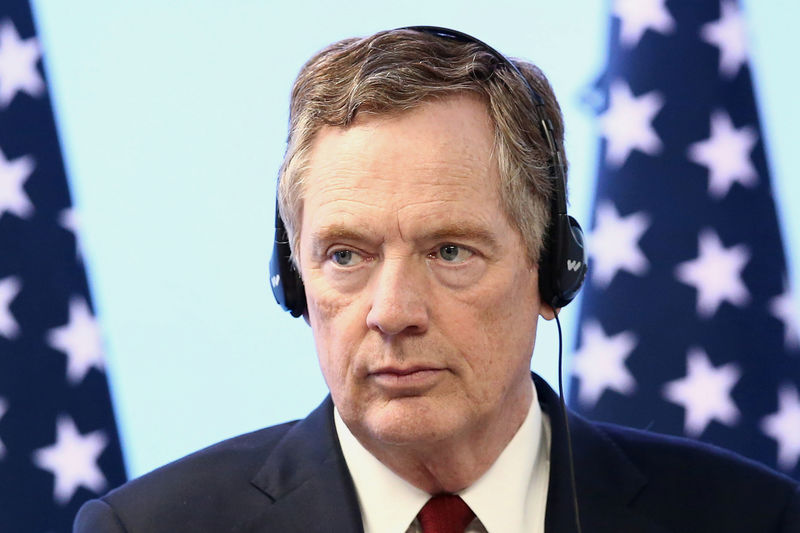 © Reuters. U.S. Trade Representative Lighthizer takes part in a joint news conference on the closing of the seventh round of NAFTA talks in Mexico City
© Reuters. U.S. Trade Representative Lighthizer takes part in a joint news conference on the closing of the seventh round of NAFTA talks in Mexico CityBy David Ljunggren and David Lawder
OTTAWA/WASHINGTON (Reuters) – Canada is ready to offer the United States limited access to the Canadian dairy market as a concession in negotiations to rework the North American Free Trade Agreement, two Canadian sources with direct knowledge of Ottawa’s negotiating strategy said on Tuesday.
U.S. President Donald Trump said at the White House that trade talks with Canada were going well and that Ottawa wants to make a deal. Chrystia Freeland, Canada’s foreign minister, returned to Washington on Tuesday for talks with U.S. Trade Representative Robert Lighthizer.
Canada’s protected dairy industry is one of three sticking points in NAFTA talks between the two countries, along with a system for settling trade disputes and cultural protections for Canadian media firms.
Trump has already struck a deal with Mexico, NAFTA’s third member, and has said he is prepared to leave Canada out of the revised deal if Ottawa fails to accept terms more favorable to the United States.
Canada’s politically powerful dairy farmers are likely to resist changes to the price controls and high tariffs that protect them from foreign competition. But as an Oct. 1 deadline to renegotiate NAFTA looms, Canada is prepared to offer similar concessions on the dairy industry to those that it agreed to in free trade deals with the European Union and Pacific Rim nations, the sources said.
“I think we understand there are certain issues on which we will need to compromise,” one of the sources said when asked about increased dairy access for the U.S. industry.
U.S. dairy farmers have long demanded more access to Canada’s market and also are unhappy about a Canadian decision to allow farmers to sell milk protein products to the country’s processors at a lower price, cutting off American supplies.
In return for concessions on dairy, Canada could request U.S. concessions on the so-called Chapter 19 dispute resolution mechanism that allows Canada to combat U.S. anti-dumping duties that Ottawa regards as unjustified. Prime Minister Justin Trudeau has said the mechanism is crucial to a new NAFTA, but Mexico already has agreed to drop it.
‘A LOT OF THINKING’
After leaving the U.S. Trade Representative offices following an initial meeting on Tuesday, Freeland described a positive atmosphere as the two sides work “extremely intensively.”
“Both sides did a lot of thinking over the weekend, so this was a very productive meeting. Having said all of that, nothing is done until everything is done,” Freeland told reporters.
Trudeau, whose federal Liberal government relies on support from Ontario and Quebec where most dairy farmers live, has said he will defend Canada’s dairy industry, without giving details.
He told reporters in Winnipeg on Tuesday, “We are better off having no NAFTA than a bad deal for Canada.”
U.S. officials have said time is running out to agree on a text that can be signed by American, Canadian and Mexican leaders by Nov. 30, before the current Mexican government leaves office. Under U.S. trade negotiating laws, a text for that agreement is due by Oct. 1.
Canadian officials have said they are working on the assumption that they have until the end of September to make a deal.
David Wiens, vice president of the Dairy Farmers of Canada lobby group, said Canadian farmers have already given up around 5 percent of a domestic market worth around C$21 billion ($17 billion).
“We have been very clear on that, that there cannot be more access given,” Wiens said in a telephone interview. “The previous two trade deals gave away a little bit and a little bit more, and so we don’t want to go down the path of death by a thousand cuts.”
In 2016, after yielding greater market access under the EU deal, Trudeau’s government paid dairy farms and processors hundreds of millions of dollars to compensate and is expected to pay out again for the Pacific deal.
Lighthizer faces pressure on dairy from U.S. Senate Democratic leader Chuck Schumer, who wants more Canadian access for milk producers from the northern part of his home state of New York. Democrats hope to take control of the U.S. Congress from Trump’s fellow Republicans in November congressional elections.
Source: Investing.com

























